This story isn’t about me, not much, but my eye goes blurry a month before I’m to play tennis at the World Masters Games. Right eye. The world will be in Edmonton — 22,000 athletes 35 years of age and up — for the games, not that Edmonton cares. It’s an athletic extravaganza that brings together more competitors than the Olympics every four years. But in 2005 Edmonton media pay no attention, consumed instead by the murder of Liana White, a twenty-nine year old mother and pregnant, by her husband.
The ophthalmologist finds burst blood vessels. “Looks like you’ve had a mini-stroke,” he says.
“Don’t say that.”
It’s as bad as anything I ever heard. Dad was cut back drastically and too early by a stroke. My sister came back from one, praise the Lord, which she does incessantly, the stroke having deepened her already intense religious disposition. Stroke runs amok in the family.
“It’s just minor,” says the eye doctor. A mini-stroke doesn’t portend a maxi-stroke, at least not necessarily, he explains. With this modest assurance I hasten for an ultrasound while he calls for a retinal specialist to repair the damage.
But it’s mid-summer and specialists are all gone fishing. The appointment is set six weeks forward and long before then I am committed to the Masters. I’m playing mixed doubles with a woman coming from Australia who has won provincial titles. It has been arranged on the games’ mating site. I haven’t met her but I’m not about to let her down.
From Edmonton I’m booked to go to Saskatoon for the Canadian Senior Tennis Championships. Here again I have a partner, flying in from Toronto.
I’m playing singles in both tournaments as well, but I’d give them a miss while waiting for the retinist if not for stranding my doubles partners. I’m not nearly as competitive as most of the guys at these tournaments. I go for those moments in locker rooms and on club verandas where I reconnect and reminisce with many I’ve played with or against since I was a boy. In Edmonton a half dozen players from Medicine Hat show up. Excited by their new tennis club there, they’re singing the praises of Pammy’s great3grandson Brian, who long ago scored a minor footnote in tennis lore as the first Canadian to meet Rod Laver on court, at a junior tournament in Ottawa. He didn’t win but he was playing those days at a level to compete with the likes of the Carpenter brothers, Mike and Keith, Smitty Chapman and Dave Pemberton-Smith. They would all chase balls in the 1950s for Davis Cup matches on the manicured grass courts at the Mount Royal Tennis Club in the heart of Montreal’s anglo west end. The hero of the time was Vancouver’s Lorne Main, already playing Davis Cup and on the international circuit at 19. Later, Keith Carpenter would make the Canadian team and he and Mike were Canadian doubles champs in 1966. Smitty was a Canadian squash champion. So was Pem-Smith, who would also partner Main to the squash doubles title. But that was long ago. The news the guys from Medicine Hat brought to Edmonton was that they had named court No. 1 at their club for Brian, who had been instrumental in getting it built. As it happens, Lorne Main is one of the guys I’d be seeing in Saskatoon.
Brian is among the second generation of the family to move west from the city of churches and city of sin where Pammy’s granddaughter Kate settled. Montreal is where all thirteen of her kids lived pretty well from childhood through expiry. Kate had been the first to venture away from the Chaffey’s Lock homestead, where some cousins remain to this day and probably always will. It was her grandkids, Pammy’s great2grandchildren, who began the exodus from Montreal, where again some remain. There are clusters of the clan east (Halifax, Fredericton), north (Yellowknife, Kuujjuuaq), west in Calgary, Edmonton, Yellowknife, Vancouver, Victoria and Bowen Island, as well as Medicine Hat. (There is no Canadian south. Toronto? Big bunch of the clan there, bien sûr.)
Brian isn’t the only one of Pammy’s clan to make his mark in the west. David, a great2grandson, is a hero in Alberta for uprooting a major company from eastern Canada and replanting it in Calgary. And high in the Coastal Mountains of British Columbia there’s a unique tribute to Jim, a great3grandson who in 1993 was the first Canadian to reach the summit of the world’s second highest mountain, K-2.
Guides and other professionals consider this to be more difficult than the more publicized ascent of Everest. K2 soars 8,611 metres at the border of Pakistan and China but can’t be seen from any inhabited place. Styled “the mountain of mountains,” it rises out of a bleak wilderness, particularly treacherous because of its steep height, frequent avalanches, savage winds, generally unpredictable weather and contours that offer little natural shelter from the elements. K2 has claimed the lives of at least thirty three mountaineers, including one who climbed with Jim’s party in ’93.
Six years later Jim himself would lose a climber’s gamble when he was swept off a cliff in Alaska by a slab avalanche. He was a well loved and respected guide and before long volunteers with The Alpine Club of Canada were planning a memorial tribute. It saw the light of day seven years later in the form of a Hut to shelter climbers traversing the Coastal chain. A wood frame structure with kitchen, sitting room and bedrooms with bunks, it’s there for anyone to use and can be reached in about a half day by climbing a few thousand metres in the Tantalus Range of southern BC from a start in Squamish. Once there, mountaineers find inscribed at the Hut, “Jim was an internationally certified full mountain guide, freelance photojournalist, national best-selling author, motivational speaker and a loving husband, son, brother, uncle, friend and mentor.” The Hut was built, “to celebrate Jim’s spirit and to remind us what a gift he was to the world.”
In 2005 in Saskatoon Lorne Main wins in his age group (75-80) as he usually does, thereby qualifying to represent Canada at the International Tennis Federation championships that year in Manavgat, Turkey. The federation, based in London, with almost a century of history, is the governing body of tennis, which is one of the few truly global sporting activities. ITF oversees 201 national tennis associations and controls the major international team events, including the Davis Cup for men and Fed Cup for women, wheelchair tennis and the Olympic Games, to which tennis was reintroduced as a full medal sport in 1988. ITF is a member of the Grand Slam Committee that controls the Australian, French, British and United States open tournaments. It also runs the global championships for junior and senior players.
In 2005 Roger Federer is the best tennis player alive. Everyone knows this. By a number of measures he may be the best of all time. But not by every measure. There’s one record that Federer will never match, let alone exceed. Perhaps the most unbreakable in all of sport, it’s a challenge at the start of every tennis season. Again in 2010, as in 2007, 2006 and 2004, as he swings for immortality by brushing aside all opponents in the Australian Open, the great Swiss champion knows it’s hopeless. Whenever he looks at the name on the stadium wall at Melbourne he knows.
Rod Laver won the Grand Slam in 1962, all four slam events — Australian, French, Wimbledon and U.S. Open tournaments — in the same year. It had been done just once before, by Don Budge in 1938. Those were the days when only amateurs were allowed to enter the slams. Greats such as Jack Kramer, founding father of the pro era, and Pancho Gonzalez, unconquered champ of its early years, were not competing. When slams opened to the pros in 1968, Laver promptly joined their ranks and won the Grand Slam for a second time in 1969. It has never happened since, not once in more than forty years. All successors, including the brilliant Federer, eat their hearts out each January in the Melbourne arena called Laver.
Nicknamed Rocket, Laver was the starburst at the peak of a procession of Australian superheros who paralyzed opponents and dominated all surfaces of the tennis world from 1950 through the 1970s. Groomed by Harry Hopman, a slam-quality player in the 1930s who became a legendary coach of young talent, they included Ken McGregor, who won the Australian Open in 1952 and was half the doubles team that won seven consecutive slam titles in 1951-52. The next open Down Under went to Ken Rosewall, who then took the ’53 French Open on Roland Garros clay. He was 19. Called Muscles by his peers for his apparent lack of them, Rosewall would go on to win more than 130 singles titles, including a dozen slams, one more than Laver in total but never all four in a single year. The slam champ of all time until Federer dethroned him a half century later was Roy Emerson, with 12 singles titles and 16 doubles, mostly partnering Aussie compatriot Neale Fraser. In reserve for the never-to-be-equaled tennis team of the century were Lew Hoad, still on everyone’s top-ten-of-all-time list, Mervyn Rose, Mal Anderson, Rex Hartwig, Tony Roche, John Newcombe and Ashley Cooper. From 1951 to 1976 Australian men won 60 of 104 slams, where the battle is one-on-one. Their teams took 15 out of 18 nation vs. nation Davis Cup ties between 1950 and 1967.
First out of the gate and first among equals of these net superstars was Frank Sedgman, who won 22 slam titles in singles, doubles and mixed doubles between 1949 and 1952, the year he won his second consecutive U.S. Open.
Sedgman was ranked No. 1 in the world in 1950 when he led the Aussies who came to play at the Mount Royal in Montreal. It was an early round in that year’s Davis Cup series. Canadian expectations were not high. Australia would win the Stanley Cup before losing a tennis match to Canada. Lorne Main, the teenage phenom from Vancouver, would get a crack at Sedgman. Not in his wildest dreams did he expect to beat him. In fact he was mercilessly racquet-whipped, trounced by Sedge 6-1, 6-2, 6-3 and out. It was particularly hurtful because it’s the first big match with his sweetheart Ivy looking on.
Ivy was perky and pretty and the little sister of the club pro. All the junior players at Mount Royal desperately craved her attention. But they had no chance once Lorne Main came to town, though some found consolation on warm summer evenings with her flame-haired younger sisters on the roof of their low-rise apartment building nearby.
Main had an unusual stroke for the day, a two-fisted backhand and forehand that he’d created to generate power and compensate for his slight build. Coach after coach had tried to wean him off it. But the day he won the U.S. 16-and-under championship Jack Kramer was watching and told him, “The two-handed grip is a winner for you. Never let anyone talk you into changing it. Stick with it.” Harry Hopman saw him use it in Montreal and thought it a great way to compensate for size. McGregor at 6’4” and Sedgman at 5’11” were sizable enough for the power game. But Hopman had a couple of smaller guys back home he said he’d get to try the two hand grip. The tennis world would be hearing a lot about them soon. “Hopman said I should go to Australia to show them the grip,” says Main. “Good thing I didn’t listen. The juniors were Laver, Rosewall and Hoad.” (Laver had his own secret weapon, which is not always appreciated. He swung his racquet from the left, a decided advantage in the game.)
It didn’t matter much to Ivy that Sedgman had trounced her guy. She loved him and, after all, Sedge was ranked number one in the world. Sedgman “was the quickest I’ve ever seen,” said Kramer. “He could attack off his second serve, or he could come in behind his little slice backhand — and once Sedge got to the net, forget it, because he was so quick you had to thread a needle to get anything past him. Anything he could get he would put away. Frank Sedgman hardly ever hit a second volley. If he got his racquet on a volley, it was almost always a placement, deep and hard.”
Lorne Main was just getting started, a couple of years past junior. He wouldn’t turn twenty for another two months. He was hope for the future. So he was blown away by the best of his time anywhere in the world. So what? Ivy was in a tennis family. She knew well the ups and downs of wins and losses.
Tennis stars were the real deal in Australia in the ’50s but this was still long before athletes became financial empires. Amateurs weren’t supposed to be paid at all to compete in tournaments, but name players got under-the-table appearance fees. “There is no such thing as amateur tennis,” Roy Emerson declared. The year he topped the rankings he was called “the highest paid amateur tennis player in the world.”
Young Australian players worked their butts off to make the touring team, after which they would get a boost, often by staging exhibitions. The money wasn’t big, but enough to get by on, particularly for a youngster. Rosewall and Laver each earned about $1.5 million over their entire pro careers, but they were exceptional. Most tennis stars of the era retired before 30 and went to work like everybody else, playing with the better local talent when work and family allowed.
Frank Sedgman was the exception. Born October 29, 1927, he passed the worst day in his life on his second birthday — Black Tuesday 1929, the day share prices on the New York Stock Exchange began a freefall that marked the onset of the Great Depression — after which he was pretty well golden.
He had always been the toast of Australia. When he was tempted to become a professional in 1951, Hopman orchestrated a public subscription through a newspaper in Sydney to keep him eligible for the amateur-only slams and Davis Cup play. The campaign raised $25,000 as a wedding gift. Frank postponed his professional plans for a year, helping Australia win another Davis Cup. He finally turned pro in 1953 and promptly broke all earnings records for tennis players, taking home $150,000 from match play and exhibitions that year.
But for Lorne Main appearance fees were few and far between. It wasn’t a bad life. Just a kid when he lost to Sedgman, the next year he won the Canadian championship, first of five in a row, and played Davis Cup for the second of five consecutive appearances. In 1951 Tennis Canada sent him to Europe, where he played Wimbledon and the French Open, losing in the early rounds but not disgraced. He wasn’t making any money but he was making good connections. Interesting people. Business executives. Politicians. And he wasn’t always knocked out early. In 1954 he won the Monte Carlo open, for more than half a century the best singles victory by a Canadian, one notch below the slams. (Milos Raonic won two ATP titles in 2011-12 to equal then surpass Main’s achievement at that level.)
By 1955 Sedgman had pretty well retired and gone into business. He acquired a gymnasium in Melbourne and started to invest in real estate. With Rosewall and Hoad, he bought into a resort hotel that did very well. He was careful with money, a trait shared by his teammates. Australians had a reputation for cautious spending and would laugh at their own “deep pockets and short arms.” The tradition carried over to their senior careers. Pancho Segura, when asked about his greatest thrill in the Grand Masters, said it was “the time Frank Sedgman picked up the dinner cheque.”
The Grand Masters tour was organized in the early 1970s to promote matches among a dozen of the big names in the game who had reached or passed their 45th birthday. This was comfortable hunting ground for players who would be legends — Vic Seixas, Pancho Gonzalez, Anderson, Emerson and, later, Laver and Rosewall. Sedgman had always stayed in shape. He came back a big winner, playing with his old, standard-size Oliver, the only wood racquet on the circuit. For half a dozen years he dominated the Grand Masters tour, even after a painful and crippling Achilles tendon snap in 1978. Following surgery he returned to win both the singles and doubles again in 1979.
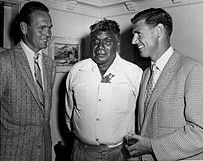
In the time of the Grand Masters: Jack Kramer (L) and Frank Sedgman (R) flank Australian aboriginal artist Albert Namatjira
As well as great competition and great entertainment for fans, the Grand Masters served as something of a refuge for the best of the forty-five-and-older tennis players. John Sharnik in Remembrance of Games Past, his engrossing history of the Grand Masters, writes that “beyond it there is nothing but the so-called supersenior tournaments for fifty-five-year-olds, for sixty-year-olds and so on. These . . . used to be disdained by most world-class players. The early rounds are populated by old geezers in elbow braces and baseball caps, with dubious strokes. The later rounds are minefields packed with danger to the prestige and egos of old champions. It can be discomfiting to find yourself bracketed in the semi-finals against, let’s say, a former twenty-fifth ranked player who has stayed in shape and worked on his strokes for twenty or thirty years, while you had no place to go but down.
“The general feeling used to be that if you’d once won Forest Hills or played in the Davis Cup, then you had nothing to prove in an old geezers’ tournament — and a lot to lose. As Vic Seixas says, ‘Eventually someone you shouldn’t lose to will beat you, and then it’s a big deal’.”
Sedgman played his last match in the Grand Masters in 1984. At the start of the schedule Rosewall was detained so, writes Sharnik, “a hurry-up call had been sent out to Frank Sedgman in Melbourne, and he had flown in, looking about as fit as a fifty-six-year-old grandfather can without being downright freakish.”
While Sedgman was swinging from success to success, Lorne Main was on a different course. There was no livelihood in tennis even after a decade at the top of the game in Canada. He had been playing since he was a kid and never held a job. In the early 1960s he joins the promotion department of the Toronto Telegram. His actual assignment is to be house pro for the larger-than-life proprietor of the paper, John Bassett, a tennis fanatic whose drive and reach will propel his son Johnny to the Davis Cup squad over bigger talents and his granddaughter Carling to No. 2 junior in the world at 14. Main keeps a good salary and Bassett’s good will as long as he shows up on court at noon to help the boss demolish the day’s competition, which often includes the Tely’s major advertisers.
“Isn’t it bad business sticking it to the customers every day on court,” he asks Johnny, who’s on court with them when he isn’t in school. “Of course. But the old man would rather lose an account than a match.”
With little else to do much of the time and few friends in Toronto, which wasn’t his home or Ivy’s, he spends hours in the club lounge, where drinks are on offer from around 11 a.m. Ivy’s time is increasingly occupied by the boy and girl they adopted and then, surprise!, by a girl born to them in 1963. Pleading family necessity, Main works a transfer to Montreal, where Ivy at least has parents, siblings and friends.
It may have seemed a good move but it broke the close tie with Bassett and left Main at the mercy of those who resented his connection to Big John. When results in Montreal fall below expectation and reports of questionable behaviour travel back to Toronto, he is vulnerable. Alcohol is playing an ever larger part in their life together. Ivy likes to drink as well. Main is just 5’8”and Ivy’s even smaller. No matter whether genetic predisposition or body size is the determining factor, it isn’t long before liquor is leading them. In 1967 Bassett fires him. Ivy is eight months pregnant with their fourth child. The family picks up and heads for Vancouver, Lorne Main’s home town.
In a succession of menial jobs — including driver for an obese, alcoholic and unscrupulous antique dealer — Main hasn’t the resources or the interest to join the local tennis fraternity. Lorne and Ivy live in isolated days of wine and roses. His face is puffy. His gut hangs over his belt. She is overwhelmed by the demands of child raising with little money. By 1974 they are reduced to returning hundreds of gallon-size sherry jugs stacked in the basement for deposit refunds to replenish their liquor supply. Not long after, Ivy dies suddenly of acute pancreatitis. A well known danger of chronic alcohol abuse, this is more common in men than women. Despondent and terrified, fearing the same end, Lorne piles the kids and the few belongings worth saving into a barely legal banger and drives 2,400 miles back to Montreal. He parks the kids with Ivy’s family and enters a residential treatment program for alcoholics at Beaver House on Montreal’s south shore, in a bleak setting opposite a cemetery. He joins A.A. and will become an ardent practitioner of its steps to sobriety.
Leaning heavily on the kindness of friends Lorne starts a long and tortuous climb back from the crater bottom. He takes on managing a small tennis club in a Montreal suburb, where he opens the doors in the morning, locks them at night and when it rains before a tournament he sweeps water from the courts to get play started. He throws himself into work, sometimes 18 hours a day. He hasn’t held a racquet in years but starts rallying with members. He’s asked to teach some juniors. Working with them he works himself into shape.
Back on the court he abandons his original two-hand grip, only to see some new stars — Andre Agassi, Jimmy Connors, Chris Evert, Jim Courier, Monica Seles, Rafael Nadal, Andy Murray — adopt it with devastating effect. The grip was not his only idiosyncracy. He subsists on an unusual diet, heavy on Pepsi and Mars bars.
One night we have dinner together, poached salmon. Born in hailing distance of the Pacific, Main tolerates fish. He shakes salt on his butter, pushes the cauliflower and beans to the side of his plate. “I never touch vegetables, fruit or salads,” he says. “Probably not a good idea for everyone but it works for me.”
Despite the fare, over the next few years he gradually regains fitness as well as self-respect and finds new challenges within the relatively close-knit tennis community. The 1980s find him teaching at a tennis academy in London, Ontario owned by Ken Sinclair, a power within Canada’s tennis establishment. Sinclair, who has never been other than fit and is uber-competitive, asks him in 1986 to be his partner for the Canadian Seniors Championship. They win the doubles and Main wins the singles title. This qualifies them as Canada’s entry to the ITF-sanctioned Austria Cup for players 55-59 in Pörtschach, Austria.
Australia wins the Austria Cup that year. The Australian team is led by none other than Frank Sedgman, still anxious to compete after superannuation as a Grand Master.
Each year, after the trials for national teams, ITF sponsors the world championship for individuals of a certain age. At Pörtschach it plays down to the leaders of the two far flung Commonwealth teams facing each other. Sedgman vs. Main, shades of that Davis Cup match in Montreal three-and-a-half decades earlier. This time the outcome is reversed. Main wins and they are even. A few years later they meet again, on Sedgman’s turf in Australia, with the same result. Lifetime score: Main 2, Sedgman 1.
Main is wound up. He wins world championships in his age bracket in 1991 in Australia, 1993 in Spain, 1995 in England, 1996 in Austria, 2000 in South Africa, 2001 in Australia.
After Saskatoon in 2005, he wins the 75-and-over in Turkey in his first year in that category, beating his friend and doubles partner Sinclair in the final. He does it again the next year, and the next. He wins again in 2011, bringing his total of world individual championships to thirteen. Main and Sinclair have captured a record thirteen world doubles titles over the same period. They have also combined to win thirteen ITF nation-to-nation tournaments.
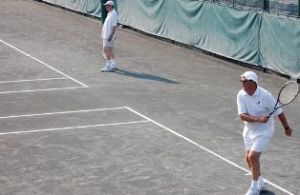
Brothers and Pammy’s great3grandsons on Mount Royal TC courts 1 and 2, 2009, Senior Nationals
At 81, with 39 gold medals, Lorne Main is the most successful senior tennis player of all time. On June 5, 2012, mid-way through the French Open, he is invited to Roland Garros in Paris as guest of honour at an ITF dinner to mark his achievement. He is the first senior player ever to earn such recognition.
As for me, I got to the quarter finals of the World Masters — my best senior result ever. I lost at Saskatoon in an early round. And it wasn’t a stroke I had that gave me blurry eyesight. Two cataract surgeries later and I see better than ever.

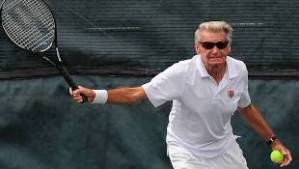
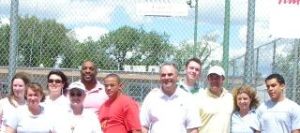
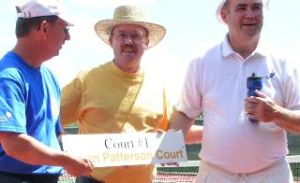
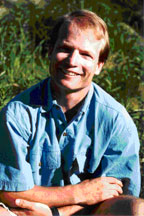

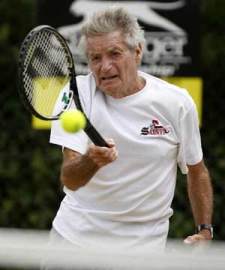
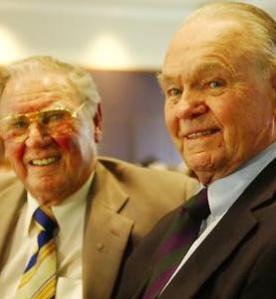
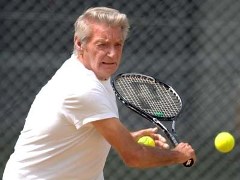

A great read dad. I remember you telling the story of Lorne Main. Didn’t know anything about Jim.
Thanks for this.
K
Date: Mon, 11 Mar 2013 20:24:53 +0000 To: kerrincooks@hotmail.com
Fabulous story – tennis must run a wee bit in the family – I play a lot too….cheers, Julia.
love your story … what a joy to read it on dad’s birthday! Happy belated birthday to you uncle Tony! Looking forward to a story about your birthday celebrations at some point in the future .. because I am hearing rumors of adventures.